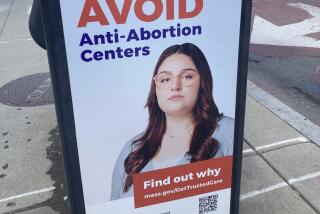Their Message: Caesareans Don’t Necessarily Follow
- Share via
Isabel Moriarty had carefully planned for the birth of her first child five years ago. She wanted to have the baby at home. She wanted no drugs or invasive procedures used. She wanted it to be an intimate, peaceful experience.
At first, things went according to plan. A midwife came and coached Moriarty through the first stages of labor. But when the time finally came to push the baby out, nothing happened. After three hours of pushing, Moriarty was told by the midwife that she would have to go to the hospital. She was rushed to a nearby hospital where an emergency Caesarean section was performed.
Moriarty had a healthy baby boy, but she was nevertheless crushed. “I had given a lot of thought to the kind of birth I wanted to have and it didn’t work out that way. In the first few months after my son’s birth, I was feeling really depressed and crazy and I didn’t know why,” she said.
It wasn’t until much later that Moriarty, a psychiatric social worker from Santa Monica, fully understood her reaction. In late 1982, she attended a conference put on in Sacramento by the Cesarean Prevention Movement, a national organization that aims at lowering what it sees as an unnecessarily high rate of Caesareans in the United States.
“For the first time I really realized I was grieving for the type of birth I had wanted to have,” Moriarty recalled.
She was particularly intrigued at the conference by talk of what the group called VBACs, vaginal births after Caesareans. Until recently, common medical wisdom had held that once a woman has had a Caesarean section, she must have a Caesarean for any subsequent birth.
Increasingly, this notion is being questioned by doctors who say that it is not necessarily true.
Moriarty, now 39, found the concept of a VBAC exciting. “Before learning about VBACs, I really didn’t feel I could become pregnant again,” she said. “I didn’t feel I could face another Caesarean.”
In March, 1984, Deborah Hamza of Los Angeles was 6 1/2 months pregnant with her second child. Her first child had been delivered by Caesarean section. He was now 4 years old and attended preschool with Moriarty’s son Blaise.
Hamza was planning to have another Caesarean section, as her doctor advised. Then she talked to Moriarty, who gave her information about VBACs.
“Before talking to Isabel, I still hadn’t worked through my fears about childbirth, so a second Caesarean was fine with me. But then I really read about the subject and decided no way,” Hamza said.
In May, 1984, Hamza gave birth vaginally to a healthy baby girl. “It was a wonderful birth,” she said.
About a year ago Hamza called Moriarty and told her she wanted to start a Los Angeles chapter of the Cesarean Prevention Movement. (The movement uses a variation of spelling for the word Caesarean.)
Now the two women and others like them are pouring their energy into getting the word about Caesareans out via CPM.
CPM seeks to educate women about avoiding unnecessary Caesareans and also is a support group for people who have had or are facing Caesareans. They have met monthly since April, drawing between eight and 25 people for their regular meetings.
As High as 25% Rate
“We really think the Caesarean rate has gotten out of hand,” Hamza, now the group’s president, said. “At some hospitals in the U.S. the rate is as high as 25%. Are they actually saying that one-quarter of all women are incapable of giving birth normally?”
The group recently had what it terms its first success.
Patti (who asked that her last name not be used) was 15 when she had an abortion by Caesarean section, an uncommon but not unheard-of method. Last year when she was 30, she got pregnant again, this time deliberately.
Patti and her husband were disappointed when a doctor told them the baby might have to be delivered by Caesarean section, but they didn’t question this traditional wisdom until they attended a baby fair in Santa Monica and visited a booth staffed by CPM.
Convinced, she found a midwife/labor coach who agreed to be with her at home for the early part of the labor. The midwife also recommended Dr. Malverse Martin, a Canoga Park obstetrician who was not only amenable to VBACs but had been doing them regularly for 11 years.
No Time for Hospital
Patti made plans to have him deliver her baby at a San Fernando Valley hospital. But then her labor began about 3 a.m. on Aug. 6. The midwife arrived at 6 a.m. She checked the baby’s position and determined that its head was ready to emerge. The midwife called Martin, but there was clearly no time to get to the hospital. Twenty minutes later Patti gave birth to an 8-pound, 5-ounce baby boy.
“My husband was there and everything went smoothly,” she said with delight.
Patti’s doctor, Martin, agreed that in most cases, the risks associated with VBACs are slight, and he is willing to let women try them. He said, however, that there are times when VBACs may not be possible.
Isabel Moriarty, meanwhile, is six months pregnant and remains optimistic that with the support of CPM, she can have another child, this one vaginally. “I may need a Caesarean again. But I can deal with that as long as I’ve given a VBAC my best shot,” she said. “CPM helps people prepare and plan for VBACs. But if I do have to have another Caesarean, I know they will rally around to support me.”
More to Read
Sign up for Essential California
The most important California stories and recommendations in your inbox every morning.
You may occasionally receive promotional content from the Los Angeles Times.














